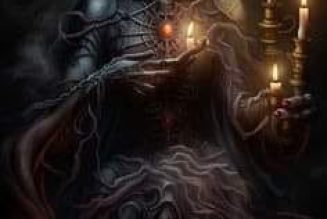There is a special connection between the spirit and its possessing location, most often the victim’s bedroom or personal place. Anything that can be moved is taken out, such as rugs, lamps, dressers, curtains, tables and trunks, to minimize flying objects. Only a bed or couch remains, accompanied by a small side table to hold a crucifix, candle, holy water and prayer book. Doors and windows are closed but cannot be nailed shut as air must be allowed to enter the room. Doorways must be kept covered, even if the door is open, or else the evil forces inside the room could affect the vicinity outside. Modern exorcists also employ a small tape recorder to validate the procedure. The priest-exorcist wears a white surplice and a purple stole. Exorcists usually are assisted by a junior priest chosen by the diocese and in training to be an exorcist himself. The assistant monitors the exorcist, trying to keep him to the business at hand and not be misguided by the perversions of the demons, and provides physical aid if necessary. If the exorcist collapses or even dies during the ritual, the assistant takes over. Other assistants may include a medical doctor and perhaps a family member. Each must be physically strong and be relatively guiltless at the time of the exorcism, so that the Devil cannot use their secret sins as a weapon against the exorcism. The exorcist must be as certain as possible beforehand that his assistants will not be weakened or overcome by obscene behavior or by language foul beyond their imagining; they cannot blanch at blood, excrement, urine; they must be able to take awful personal insults and be prepared to have their darkest secrets screeched in public in front of their companions. Rites of exorcism. Rituals vary from a spiritual laying-on of hands by a clairvoyant exorcist, taking the entity into his or her own body and then expelling it, to the formal procedure outlined in the Catholic Rituale Romanum. Salt, which represents purity, and wine, which represents the blood of Christ, figure prominently in exorcisms as well as strong-smelling substances such as hellebore, attar of roses and rue. Members of many faiths—Hasidic Jews, Muslims, Hindus, Protestant Christians and Pentacostal Christians— practice exorcism, but only the Roman Catholic church offers a formal ritual. In India, Hindu priests may blow cow-dung smoke, burn pig excreta, pull their or the victim’s hair, press rock salt between their fingers, use copper coins, recite mantras or prayers, cut the victim’s hair and burn it or place a blue band around the victim’s neck to exorcise the demonic spirits. Trying another tack, the exorcist may offer bribes of candy or other gifts if the spirit leaves the victim. Early Puritans relied solely on prayer and fasting. The official exorcism ritual outlined in the Rituale Romanum dates back to 1614, with two small revisions made in 1952. Cautioning priests to make sure a victim is truly possessed before proceeding, the rite includes prayers and passages from the Bible and calls upon the demons, in powerful Latin, to depart in the name of Jesus Christ. While no two exorcisms are exactly alike, they tend to unfold in similar stages: 1. The Presence. The exorcist and his assistants become aware of an alien feeling or entity. 2. Pretense. Attempts by the evil spirit to appear and act as the victim, to be seen as one and the same person. The exorcist’s first job is to break this Pretense and find out who the demon really is. Naming the demon is the most important first step. 3. Breakpoint. The moment where the demon’s Pretense finally collapses. This may be a scene of extreme panic and confusion, accompanied by a crescendo of abuse, horrible sights, noises and smells. The demon begins to speak of the possessed victim in the third person instead of as itself. 4. The Voice. Also a sign of the Breakpoint, the Voice is, in the words of Martin, “inordinately disturbing and humanly distressing babel.” The demon’s voices must be silenced for the exorcism to proceed. 5. The Clash. As the Voice dies out, there is tremendous pressure, both spiritual and physical. The demon has collided with the “will of the Kingdom.” The exorcist, locked in battle with the demon, urges the entity to reveal more information about itself as the exorcist’s holy will begins to dominate. As mentioned above, there is a direct link between the entity and place, as each spirit wants a place to be. For such spirits, habitation of a living victim is preferable to hell. 6. Expulsion. In a supreme triumph of God’s will, the spirit leaves in the name of Jesus, and the victim is reclaimed. All present feel the Presence dissipating, sometimes with receding noises or voices. The victim may remember the ordeal or may have no idea what has happened.
The Setting of an Exorcism.
817 views



































